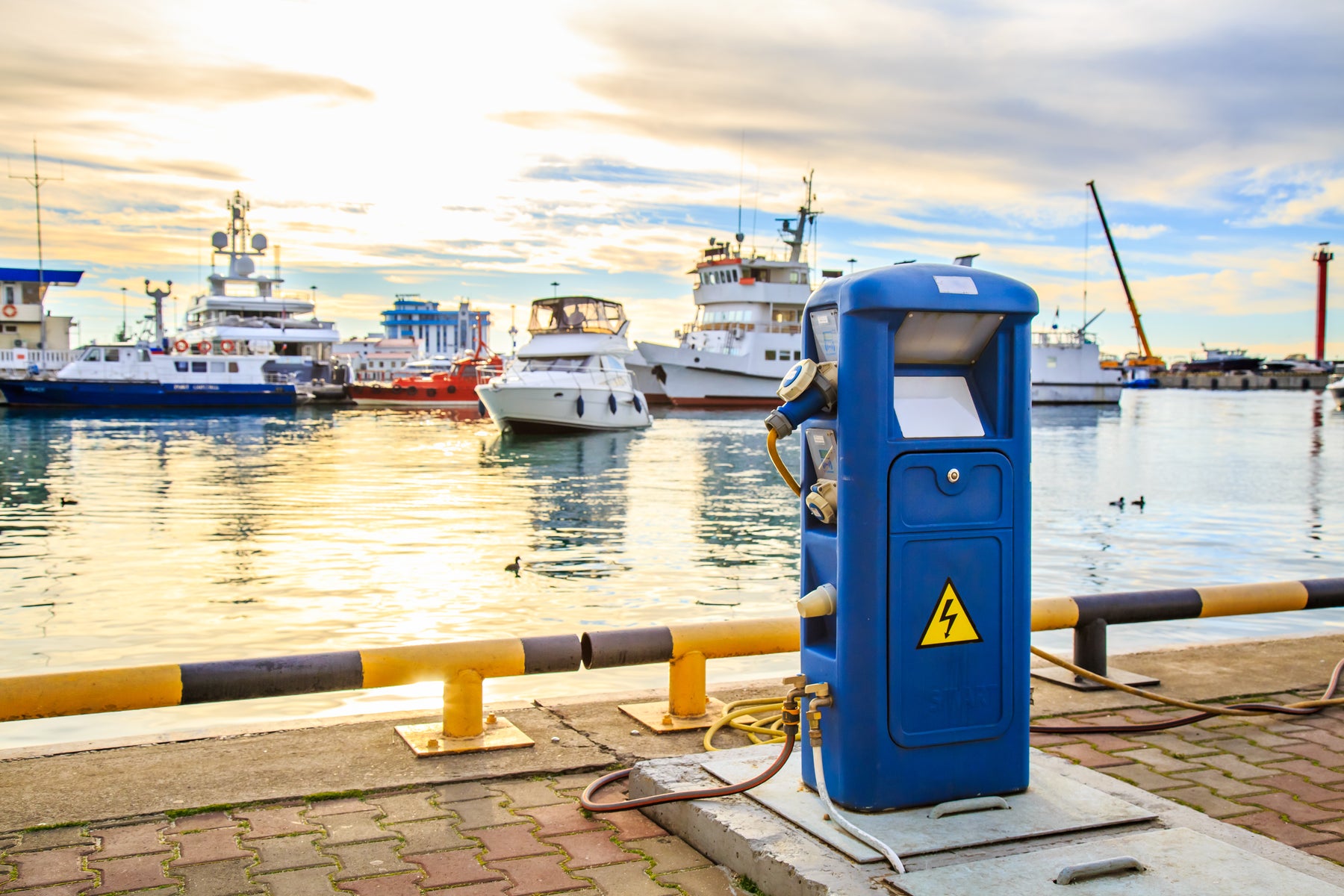
Offshore and Dockside Power Explained by ATI’s Marine Experts
Dockside power centers are electrical housing units located outside at a marina, boatyard, or private dock. These units use power from a shoreside supply transformer to provide marine vessels with alternating current (AC) electricity. While connected to a shore power system, marine vessels can turn off their generators and have access to AC power. This gives the boat’s generators a break and helps cut down on fuel costs and emissions. Also, you should never run your engines constantly while docked at a marina. It’s much safer to turn off the engines and connect to shore power. In this article, we’ll take a deep dive into what offshore and dockside power looks like for different types of marine vessels.
How Does a Yacht Receive Offshore and Dockside Power?
There’s no doubt that yachts are the most luxurious ships on the sea. The bigger the yacht is, the more luxurious it’s considered to be. Thirty years ago, a 40ft vessel was considered a large marine recreational vessel. Now, a 40ft vessel is used as a tender on a super yacht. A ship needs to be longer than 165 feet to be considered a super yacht, though there’s technically no limit to how large a super yacht can be. In fact, the world’s largest yacht comes in at a jaw-dropping 728 feet!
While strolling through the open water, a majority of yachts generate offshore power by using diesel engine generators. The generator produces AC power to power things like lights, TVs, electronic navigation systems and even restaurant style kitchens.
To give the systems providing offshore power to yachts some time to relax, yacht owners visit marinas to connect their vessels to dockside power sources. Components of marine shore power for yachts include shore power pedestals, shore power cables, and a yacht shore power inlet. Some power pedestals even include additional features such as a cable and water hookup to provide ship owners with extra comfort.
Shore power cables, such as our 100A 2/4 yellow shore power cable, are sturdy cables that are specially designed for use in marine environments. Our 2/4 STOW cables are marine rated and have a bright yellow cable jacket for superior visibility underwater. This cable is sold by the foot and comes with or without connectors that will lock into place and securely connect a yacht to the power pedestal’s inlet.
Offshore and Dockside Power for Cruise Ships
Have you ever found yourself relaxing on a cruise and wondering how it was powered? The various restaurants, bars, and staterooms on cruise ships demand a massive amount of electricity. While cruising through the open ocean, cruise ships often generate offshore power by using diesel generators.
There are three main categories of diesel engines used on cruise ships: direct drive, diesel/electric, and gas-powered turbines. Direct drive is the simplest of the three. It functions by using an ignition of fuel to drive pistons and eventually create power output. New ships often feature diesel-electric propulsion that uses massive generators to power the ship’s main engines. Finally, gas turbines convert gasoline to mechanical energy that can be transformed into electricity.
Considering the amount of electricity that cruise ships need, shore power looks slightly different for cruise ships than for smaller vessels. Shore power for cruise ships is known as high-voltage shore connection (HVSC) or cold ironing, a specialized electrical system that allows these large ships to connect to a dockside power source while they are docked at ports.
Ports and terminals for cruise ships feature a bit more heavy-duty equipment than yacht shore power stations do. This includes transformers, switchgear, and power distribution systems capable of delivering electricity to cruise ships at the required voltage. Cruise ships are equipped with specialized shore power connection points that are typically located on the vessel's hull and align with dockside connectors for a waterproof electrical connection.
Providing Offshore and Dockside Power for The Fishing Industry
In the same way that cruise ships rely on diesel generators for offshore power, they’re also a very common option for commercial fishing vessels. If you’ve ever owned a diesel truck or diesel-powered generator, you’ve likely experienced why the ship’s engineers love this type of engine. Diesel generators are known to be durable and fuel efficient, which makes them a great option for long journeys with heavy loads. Most commercial fishing vessels feature several diesel-powered engines to drive the boat’s propellers.
To give the ship’s diesel motors a breather, commercial fishing boats must be compatible with the electrical connectors in each port they visit. This includes places along the dock equipped with the plugs and voltage levels needed for each ship. Certain ports and regions even require fishing vessels to use shore power to reduce emissions.
The availability of shore power varies in ports across the world. Major ports in developed countries are more likely to have shore power infrastructure, while smaller ports in less developed areas might not. The adoption of shore power technology continues to spread as environmental regulations become more strict, and vessel operators look for ways to reduce emissions and extend the life of their engines.
Why You Need Efficient Offshore and Dockside Power
Shore power provides a stable supply of electricity for charging boat batteries, running appliances, and maintaining systems like HVAC to keep passengers comfortable. Dockside power is standardized for compatibility with different types of boats. If you’d like to learn more about shore power, check out our previous blog, Marine Shore Power Basics: What You Need to Know. We also offer a wide selection of equipment specialized for the marine industry. For any questions about this blog or to request a quote on ATI’s shore power equipment, please contact us at PPG@atielectrical.com. You can also call us directly at (800)-597-9311 today!

 CALL OR TEXT NOW 800-597-9311
CALL OR TEXT NOW 800-597-9311
Leave a comment